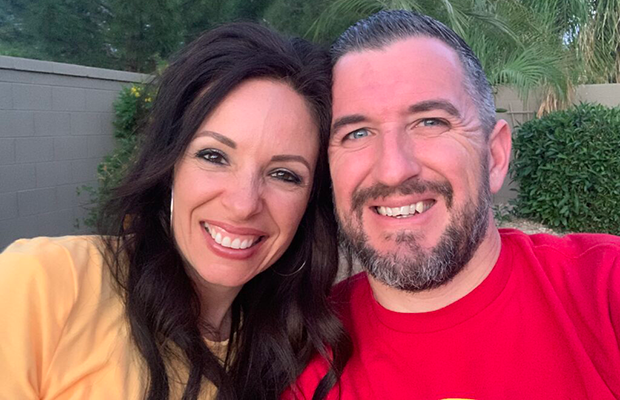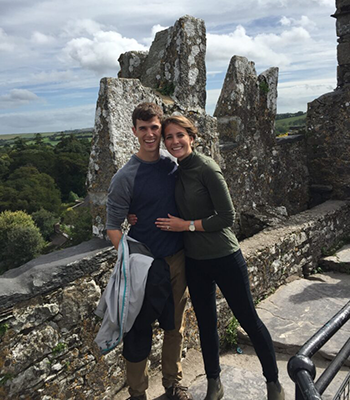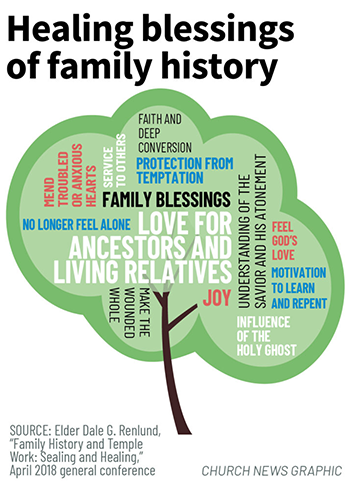How These Latter-day Saints Found Healing through Family Stories
Contributed By Sydney Walker, Church News reporter

A father and daughter look at family history documents together. Family history and temple work has helped some Latter-day Saints find healing from traumatic family events.
Article Highlights
- Participating in family history and temple work has helped some people heal from traumatic family events.
“Every situation is just different. But I know for me, I was a broken, shattered human being. And through doing family history, I no longer am a broken, shattered human being from this experience.” —Camaron Perkins
Related Links
Editor’s note: This is part three in a series on the healing blessings of family history based on Elder Dale G. Renlund’s April 2018 general conference talk “Family History and Temple Work: Sealing and Healing.” If you or someone you love is struggling with suicide or abuse, please visit the Church’s Life Help website or talk to a professional counselor.
One afternoon about three and a half years ago, Camaron Perkins received a phone call she will never forget. Her father—her “rock” and “spiritual giant”—had died by suicide after psychological reactions from ending a medication.
“In that moment, my world shattered into a million tiny, little pieces,” said Perkins, a mother of four and member of The Church of Jesus Christ of Latter-day Saints who lives in Queen Creek, Arizona. “It was the most unnerving, unsettling feeling I have ever felt in my life.”
The pain she felt was difficult to describe with words. More than anything, she wanted her father to know she still loved him. “I just wanted to say . . . ‘I need you to know that I love you, no matter what. This has not changed my love for you whatsoever. . . . This is hard, but we’ll be OK.’”
A few weeks later, as reality sank in and she continued to process her feelings, Perkins said she had a distinct impression: “Don’t let this one moment in time define your father. That’s not who he is. That’s not who he was. . . . You’ve got to find a way to define his life and celebrate his life.”
Perkins said a thought came to start adding memories to her father’s profile in the FamilySearch Family Tree app. She added picture after picture, story after story. Memories from her childhood came flooding back.
“I knew it was the Spirit that was giving me these memories and bringing them to my mind so that I could preserve them in honor of him,” Perkins said. She even found old cassette tapes with recordings of her father’s voice he had used as an audio journal.
For about a month, Perkins spent a few hours a day adding memories to his FamilySearch profile. She described the process as “healing”—little by little, day by day.
“I discovered, as I was doing this, all those feelings of pain and agony were leaving me, and they were being replaced by feelings of joy and wonderful memories and love for my father,” she said. “My love for him was increasing, which I didn’t think was even possible, because I loved him so much.”
“I know it was the healing power of the Atonement of Jesus Christ,” she continued. “There are many tools to feel that power, but I was able to experience it through a simple family history tool.”
Elder Dale G. Renlund of the Quorum of the Twelve Apostles spoke of the healing blessings of family history and temple work promised by prophets and apostles during the April 2018 general conference.
One such blessing, Elder Renlund said, is “increased love and appreciation for ancestors and living relatives, so we no longer feel alone.” Another is “increased family blessings, no matter our current, past, or future family situation or how imperfect our family tree may be.”
Perkins and other Latter-day Saints have experienced these blessings and more as they’ve participated in family history and temple work and found help in healing from traumatic family events.

Camaron Perkins, left, is pictured with her husband, Jeff, in April 2020. After she lost her father to suicide, Perkins found strength and healing by preserving memories and photos of him in the FamilySearch Family Tree app. Photo courtesy of Camaron Perkins.
Finding Support in “Complicated Stories”
Sarah Hammon described her childhood in Holladay, Utah, living with her mother, father, and brother as “picturesque.”
She and her family weren’t members of the Church at the time, but her parents—both engineers—had an “amazing” relationship and were very involved in her life. She remembers them coaching her sports teams and volunteering at her school.
“But my dad, unfortunately, has a lot of mental-health struggles, and he decided to medicate with alcohol,” said Hammon, who now works as a senior marketing manager for FamilySearch. “Over time, he couldn’t hold down a job, and he was really angry and would sometimes be violent.”
This put emotional and financial strain on her family. A teenager at the time, Hammon was angry with her father.
When she was a senior in high school, her father was arrested for domestic violence and her mother filed for divorce. The damaged relationship with her father—as well as his family—was painful.
Hammon joined the Church at age 19 after investigating for a few years. A friend encouraged her to take a family history class at institute, and she began learning more about her family lines. Watching her family tree grow was a “soothing process,” she said.
“As I built out specifically my dad’s side of the family, even though I couldn’t feel particularly close to him, I could feel close to his grandparents and his great-grandparents, and especially learning their stories.”

Sarah Hammon, right, is pictured with her husband, Grant, in Ireland, where her third-great-grandmother Ellen Harrington’s parents were born. Photo courtesy of Sarah Hammon.
For example, she found a photo of her third-great-grandmother Ellen Harrington with her husband and nine sons. As she dug deeper into her life, Hammon discovered Ellen had three daughters who died in infancy—two before her sons were born and one later on.
“It made me realize if anyone deserves to be sealed to their daughters, it’s this woman who raised nine sons—nine really faithful, devoted young men who married and had really productive, wonderful families of their own.”
Hammon said learning of ancestors who had “complicated stories” and “complicated lives” helped open her heart and reconcile with her father’s side of the family. She thought, “Maybe I should give my living relatives the benefit of the doubt.”
This mindset change opened the door to working with her father’s siblings to build their family tree. Now Hammon said that relationship is closer than ever, and she has a greater love and appreciation for them. “They’re really devoted to their families. They love their brother.”
Family history has also opened some doors to mending the relationship with her father.
“Specifically with my dad, I’ve been able to heal that relationship just by sharing, ‘Hey, I found it’s your second-great-grandfather’s birthday today. Did you know that?’ or I found a picture of one of his ancestors that looks exactly like him[,] . . . and we were able to have a good conversation about that.”
During the toughest moments, doing temple work for her father’s side of the family helped her feel peace and support from her ancestors.
“When we feel close to them, we can feel that kind of support in that healing, that they care about us and they want us to succeed in this lifetime,” Hammon said. “They want to pass on to us what they know. And most of the time, the only way that we can figure that out is by understanding their stories.”

Sarah Hammon’s third-great-grandmother Ellen Harrington is pictured with her husband and nine sons. Learning of ancestors who had “complicated lives” helped Hammon through challenges with her father and his side of the family. Photo courtesy of Sarah Hammon.
Clinging to a Prophet’s Promise
During breakfast with her young children one morning about nine years ago, Lisa Ashby collapsed on the floor. She could hardly move her hands and feet.
These episodes of tingling in her limbs continued to come and go—making it difficult to walk and impossible to lift things, said Ashby, a member of the Church who lives in South Jordan, Utah, with her husband, Devin, and five children.
Ashby thought her symptoms were signs of multiple sclerosis, a disease her aunt had that resulted in nerve damage. After seven years of altering her diet, sleep, and exercise patterns to lessen the symptoms, she met with an MS doctor.
“He told me I did not have MS but that I have physical manifestations of repeated childhood and adult traumas,” she recalled. She felt the Spirit confirm this was true.
Ashby’s childhood in Tucson, Arizona, included abuse, grief, and loss. Her mother was divorced when Ashby was 6 years old and again when she was 10. As a high school student, Ashby lost three friends to a car accident and two to suicide, and one was murdered. She also lost her grandfather during that time. Her mother divorced again when Ashby was 34.

“Along with all the bumps and bruises of living in mortality,” she said, “my body had had enough and started shutting down.”
After discussing the likely cause of her physical impairments with the MS doctor, Ashby said she turned to the Lord in humble prayer. “I could not change the past or what had happened to me, but I could face the reality of it, unbury it, and give it all over to the Master Healer,” she said.
Ashby said the Spirit guided her to know how to deal with those issues. “As I was able to write down and verbalize the abuses and traumas in my life and put a name to it, along with fasting and great prayer, I was able to heal,” she said.
“I learned that telling the good and bad from my own personal history was helping me heal physically,” she said.
She learned of an ancestor named Hazel who lost her husband in an explosive mine accident months before their first baby was due. She later remarried twice. Ashby saw some parallels to her mother’s marriages.
“As I have their pictures around me and I know their stories and I am familiar with them, it makes it possible to feel their spirits in my life,” Ashby said of her ancestors.
Inspiration also came as she listened to the October 2018 general conference, in which President Russell M. Nelson said, “I urge you to find a way to make an appointment regularly with the Lord—to be in His holy house—then keep that appointment with exactness and joy.”
He promised: “The Lord will bring the miracles He knows you need as you make sacrifices to serve and worship in His temples” (“Becoming Exemplary Latter-day Saints,” Ensign or Liahona, Nov. 2018, 114).
President Nelson’s invitation “stung” Ashby’s heart, and she set a goal to do 100 temple ordinances for her deceased family members—a task that wouldn’t be easy with five young children. But she made the sacrifice and clung to his promise.
She found comfort in Elder Renlund’s promise from the April 2018 general conference: “As you accept President Nelson’s invitation, you will discover, gather, and connect your family. . . . You will find healing for that which needs healing” (“Family History and Temple Work: Sealing and Healing,” Ensign or Liahona, May 2018, 49).
Two years have now passed without an episode of tingling in her limbs. “Slowly over time, almost subconsciously, I noticed the change happen,” Ashby said. “I just leaned into the promise of a prophet.”
She continued, “When I made time to understand those promises and decided to make that sacrifice of time, I was able to have healing for that which needed healing and ultimately become whole through the Master Healer.”

Lisa Ashby, middle right, is pictured with her husband, Devin, and their five children. Through temple and family history work, Ashby found healing from childhood trauma. Photo courtesy of the Ashby family.
Don’t “Define the Miracle”
J. Nathan Acree, a licensed clinical social worker and project manager of development and training for Family Services, said he has seen a few examples of family history helping clients through traumatic events.
One man who had a rough experience with his adoptive parents found hope and connection through researching his family line. As he found relatives—and eventually his birth mom—he was able to “reangle” his life.
“It was healing to have found that he belonged somewhere,” Acree said. “Just that ability to help him ground himself and say, ‘Hey, there are people I’m connected to. I could move past this horrible childhood I had.’”
Another example is a mother who was an abuser. Learning about her own abuse and her mother’s situation “helped her change her ways, to heal from her own abuse and stop that cycle of abuse she was having with her own kids,” Acree said.
“While that’s not going to be the panacea for every single person,” he said of family history, “certainly for some individuals that can be helpful for them.”
Ultimately, everybody’s journey is different, Acree said. Ashby and Perkins echoed similar thoughts.
When depending on the Lord for help, the cautionary tale, Ashby said, is not defining what the miracle is. The Lord knows the miracles His children need.
“There’s so many along the way,” she said. “But not everybody gets healed by doing X, Y, and Z. . . . The Lord knows us well enough to know what we need when we need it.”
Recognizing there are many who have lost family members to suicide and may not find the same strength in family history, Perkins said: “Every situation is just different. But I know, for me, I was a broken, shattered human being.
“And through doing family history, I no longer am a broken, shattered human being from this experience.”
